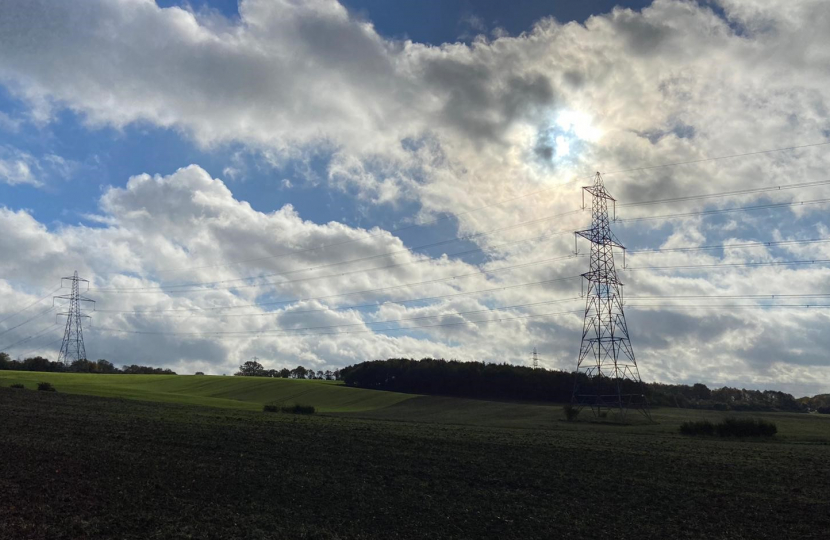
My response to National Grid's East Anglia GREEN consultation can be found below:
OFFSHORE TRANSMISSION IS THE FUTURE – AND WE HAVE TO START NOW
IN A NUTSHELL:
- It is clear from correspondence that my constituents, likely to be very directly affected by new conventional ‘overland’ pylons resulting from East Anglia GREEN (EAG), overwhelmingly favour an offshore transmission option instead.
- I strongly agree – but whilst the impression is given in communications from National Grid that this is somehow impossible, it is ALREADY the case that huge undersea cabling is underway… it’s just that the overwhelming majority is taking place off Scotland and the North of England.
- We want a fairer share for East Anglia, commensurate with our enormous contribution to offshore wind generation.
- EAG’s proposed ‘swathe’ has been explicitly chosen against an undersea option, ‘Sealink 2’; and yet National Grid have confirmed that Sealink 2 would be used if ‘further’ generation capacity was needed – so it’s clearly in play as an option.
- But not using Sealink 2 at this stage assumes a relatively small capacity of offshore cabling – yet total mileage of committed offshore transmission cabling is 10:1 in favour of Scotland/north of England. With a levelled-up allocation for the East and South East (i.e. Kent) we could exceed the carrying capacity of overland pylons and most importantly…
- Deliver an offshore grid. Building an offshore grid is Government policy, and yet this clear policy objective – essential if we are to deliver our scale of offshore wind generation - has been decoupled from National Grid’s considerations on EAG. We must ensure that the commitment to an offshore grid is central to existing (‘in flight’) transmission schemes, including EAG.
- Finally, whatever one thinks of the arguments for and against the offshore option, it is surely wrong that my constituents, and my colleagues in East Anglia, have been presented with a ‘fait accompli’ consultation that shuts them out from the original decision not to go undersea and pursue Sealink 2.
I therefore 100% re-enforce the point made by myself and 7 other MPs* that the consultation must include offshore options as well, thus giving the public a chance to have their say on the top-level choice of overland v undersea.
*A joint letter, link here and attached below, was sent to Energy Minister Greg Hands MPs on 20th May 2022, endorsed by 8 MPs (signed by 6 but subsequently endorsed by Rt Hon John Whittingdale MP and Will Quince MP), calling for the consultation to include offshore options. Original signatories: James Cartlidge MP, Sir Bernard Jenkin MP, Dr Dan Poulter MP, Jo Churchill MP, Kemi Badenoch MP and Richard Bacon MP.
FACTS: UNDERSEA ELECTRICITY TRANSMISSION IS ALREADY A REALITY
Due to recent media coverage of EAG, people might have been forgiven for concluding that offshore electricity transmission is neither practicable nor possible – a science fiction fantasy, convenient for those communities not wanting new pylons ‘in their backyard’. In fact:
- We already have commitment to one undersea electricity cable in the East, Sea Link (i.e. ‘Sea Link 1’). This will run from Suffolk to Kent, entirely offshore.
- East Anglia GREEN’s proposed overland pylon route was explicitly chosen against a proposal for an undersea cable or ‘bootstrap’ – this would have been ‘Sealink 2’.
- Most significantly, two huge undersea bootstraps have been built, or are in process, off the eastern and western coasts of Scotland, for bringing power south into the North of England, and North Wales respectively. These are the Eastern and Western Links.
It is worth stressing that the eastern and western links massively outstrip Sealink 1 in terms of cable mileage, and therefore, cost.
What we know:
- Western Link - Cost: £1.02Billion, Capacity: 2.2GW, Mileage: 770km undersea, 478.5miles - Link connects the west coast of Scotland with Quay Bay, on the north coast of Wales.
- Eastern Link - Estimated Cost: £3.4Billion, Capacity: 4GW (Combined capacity as 2 cables), Total mileage for 2 cables: 616km (382miles) undersea - consisting of 440km from Peterhead to Drax (273 miles) and 176km offshore from Torness to Hawthorn (109.3miles).
- Sealink 1 - Estimated Cost: £1.2Billion, Capacity: 2GW, Mileage: 130km offshore, 80.7 miles - Link will connect Sizewell to Kent.
- The total mileage of undersea cabling off Scotland to Wales and the north of England is around 860 miles.
- Hence, the scale of undersea cabling already agreed is 10:1 in favour of Scotland/North of England, despite the huge importance of East Anglia’s offshore wind farms, and the great and growing impact of densely concentrated onshore infrastructure.
If East Anglian/South Eastern offshore cabling was allocated the same financial commitment as Scotland/Northern England, we would be able to deliver Sealinks 2, 3 and 4 – ensuring more than the 6GW an overland pylon run will provide.
THE CASE FOR OFFSHORE TRANSMISSION… BY NATIONAL GRID
MPs and constituents arguing for why we should deliver offshore transmission do not have to look far to find the same arguments already being used… by National Grid, to justify Sea Link (what we refer to as ‘Sea Link 1’). www.nationalgrid.com/electricity-transmission/network-and-infrastructure/sealink
- The main justification for Sea Link by National Grid is, quite rightly, the push for ‘net zero’ and the need for 40GW of offshore wind by 2030. As it says, “more needs to be done to meet the Government’s targets, and our national electricity network must evolve to connect far more coastal renewable generation in order to reach the 2050 target”.
- On ‘why Suffolk’, the justification for Sea Link also rightly says: “As a result of this increase [in renewable energy], the existing network in Suffolk does not have the capability needed to reliably and securely transport all the energy that will connect by 2030 out of the region. Adding a new High Voltage Direct Current (HVDC) electricity link will provide additional capacity to deliver that clean, green energy to where it is required”.
- On ‘why Kent’, i.e., why a Suffolk-Kent undersea cable, National Grid make the crucial ‘big picture’ argument about the need for wider interconnectivity:
- “These additional power flows cause equal challenges on the network in Kent. During periods of high wind generation from offshore wind farms on the east coast, electricity will need to be exported to Europe via interconnectors to balance the electricity network. Many of these interconnectors being developed will be located along the south and east coasts of the UK, where the majority of the UK’s existing interconnectors are already located.
- “But to enable this surplus electricity to be exported, energy has to be first transferred from where it is received in East Anglia to where interconnectors connect into the network in Kent and the rest of south-east England. In times of low wind generation, we will also need to import electricity through these interconnectors to meet national demand. Our existing network is not able to cope with this level of transmission between the two regions, and so we need to develop a new undersea link between the locations where energy is connected into the network and where it’s imported and exported out of it.
It concludes:
“By connecting East Anglia and Kent, Sea Link will provide the additional network capacity needed to enable the import and export of wind energy to and from Europe”.
THE STRATEGIC PICTURE – BUILDING AN OFFSHORE GRID
A key point about EAG is that the proposal seems to have been considered in a parallel universe – one where we are not moving towards an offshore grid; one where the Government doesn’t support that outcome:
- We are moving towards an offshore grid – offshore wind cannot expand at the rate demanded without one.
- The Government DOES back this ambitious but necessary infrastructure development, which would save billions for customers in the long run; protect onshore and coastal communities from ever more disproportionate infrastructure impact, but significantly too, it would assist strategically in enabling our move to energy independence, a core strategic goal in light of Russia-Ukraine.
The Prime Minister confirmed the Government’s position in answer to my PMQ on 19th May 2021:
James Cartlidge
‘I thank the Prime Minister for the support he has already shown for coming forward with an offshore transmission grid, which he knows will help us to both export our surplus offshore wind to the continent and reduce the infrastructure associated with new wind farm capacity. It is very important to our communities, but there is a question over timing. Given that he has already set out an ambitious and clear timetable for increasing offshore wind generation, will he now come out with an equally ambitious timetable for delivering an offshore grid?’
The Prime Minister
‘My hon. Friend is spot on in what he says about the need for an offshore grid. As well as building the fantastic windmills, it is vital that we bring the energy onshore in a way that has minimal disruption for local communities and enables us to maximise efficiency.’
There are two further important reasons for pushing for an offshore grid:
- Benefit to consumers – in October 2020, National Grid ESO calculated that taking an integrated approach to offshore connections could save consumers £6 billion.
- Benefit to businesses – I believe that it is not in the interests of offshore wind operators, and their linked commercial interests, to find their ability to expand constantly bogged down in vocal opposition from disproportionately affected communities. Whilst there will always be a need for some onshore infrastructure, a rapid push to a coordinated offshore grid, maximising use of undersea connectivity, would surely result in far less impact. Dermot Nolan, who led Ofgem until January 2020, said in October of that year that a ‘coordinated offshore grid needed to be developed’ because of the sheer onshore impact of offshore wind related infrastructure.
Of course, these benefits are in addition to the crucial ones for my constituents – avoiding the despoiling of beautiful countryside, and the direct impact on the homes and villages of our rural communities.
CONCLUSION – SEA LINKS 1, 2, 3 and 4
As stated in my question to the Prime Minister, and as is a key justification by National Grid themselves for Sea Link 1, the use of a coordinated offshore transmission network has a principal advantage of driving the ‘interconnectivity’ essential to export our offshore surplus – and importantly, to import when the wind is quieter here, but not in neighbouring markets.
If East Anglia were to have its ‘fair share’ of offshore infrastructure investment, not undermining offshore cabling elsewhere, but bringing our commitments up to the scale seen in Scotland/northern England - we could then use EAG as a positive opportunity to genuinely drive forward a piece of infrastructure that is in our strategic energy and overall national interest - an offshore grid.
In essence, the questions that National Grid need to address for my constituents are as follows:
- You say an undersea option is not technically possible for East Anglia GREEN, so why are such options possible off Scotland and northern England?
- If you recognise that they are technically possible, but there is not enough ‘scale’ for your needs, why can you not simply deliver Sea Links 2, 3 and 4?
As previously mentioned, it appears by latest estimates that we will have 1 mile of electric cabling off East Anglia, for every 10 miles off Scotland/northern England.
- Why can we not increase our scale of cabling, so that we can deliver EAG through a Sea Link 2 of dual or treble cabling (like the Eastern Link), and in so doing, truly start building an offshore grid?


